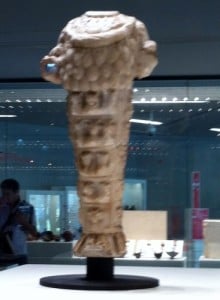
“Greek civilization is alive; it moves in every breath of mind…” – Will Durant, historian and philosopher. Marseille, France, an urban center in decline, is experiencing a rebirth by remembering its roots. “Massalia, Massilia, Marseille, three names for an identity created through the marriage of a Ligurian princess to a Greek sailor from Asia Minor 2,600 years ago,” according to the 2013 Muse D”Histoire De Marseille brochure. Despina Siolas, M.D. /Ph.D. embarked on an exciting trip in to her Ionian heritage on a recent trip to Marseille.
A new Musee d’Histoire de Marseille (Museum of European and Mediterranean Civilizations) located in the Bourse site is dedicated to Mediterranean civilization. Marseille is hoping to shake off its negative’ reputation in France, as the deadliest city.
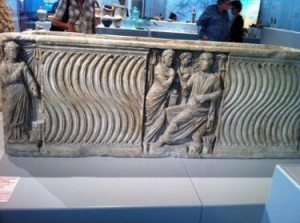
Jean-Claude Gaudin, Mayor of Marseille and Senateur for Bouches-du-Rhone said “Marseille-Provence has been designated European Capital of Culture for 2013. The city has an opportunity to strength its culture as a means of demonstrating the region’s appeal as a factor in the development of tourism. There are single items alongside animated series using a variety of multi-media tools, all of which are key to understanding the common history that we are keen to share with as many people as possible.”
Mayor Gaudin in the tour diary “Musee D’Histoire De Marseille” believes he is “proud to be involved in the initiation of this great museum, the only one of its kind in France; it is the heart of an ambitious urban plan, very much dedicated to providing a high quality museum experience that will benefit everyone in Marseille and further afield…One specific item forms the focal point around which each series in the museum journey unfolds, as do encounters with leading witnesses (such as the sailor and geographer Pytheas and Alexandre Dumas’ hero, Edmond Dantes).” It is the first in the world dedicated to the heritage of the Mediterranean basin.
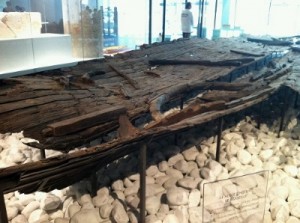
This article will concentrate on the Greek culture exhibits. The art comes from the former Paris’ Museum of Popular Arts and Traditions, loans from other museums, particularly from Greece. In Series I “The Marriage of Gyptis and Protis, The Legend of the Founding of Marseille”, the exhibit quotes the fifth century BC historian Herodotus. “The people of this city (Phocaea) were the first Greeks to make distance sea voyages; they discovered the Adriatic Sea, Tyrrhenia, Iberia and Tartessos; they did not sail in round ships but on pentecontors,” the Histories, Book I,163. Around 00 B.C., Greeks from Asia Minor, Turkey, founded a city on the Lacydon inlet in the present Panier district.
The temples of the Ephesian Artemis, Apollo of Delphi and Athena Polias Gods protected the city. An Ionic capital from a 600 B.C. monument came from a temple. Legend states that a Gallic princess, Gyptis married a Greek sailor Protis. King Nannos, her father, gave them Massalia, the oldest city in France, as a wedding gift. The Phocaeans, who were probably driven from their homes by the Persians in 546 B.C., brought with them their religion, language, building techniques, cultivation of the vines, olive trees, and commercial products such as wine and Mediterranean ceramic vases. Massalia created coins, using a weighing system used in the cities of Ionia. The adobe architecture and grid lined urban planning districts was that of the Greek cities of Ionia. The Greek Gallic encounter created a rich culture.
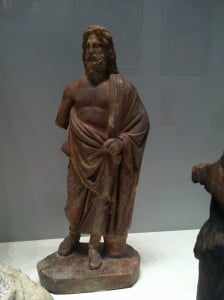
“Marseille and the Gauls of Provence” describes an original Greek-Gaul civilization with mixed marriages. This is proven by Celtic (early tribes of Ireland, the western and northern parts of Great Britain (Wales, Scotland, and Cornwall), the Isle of Man, and Brittany) and Greek style pottery. The development of these relationships were from 600 B.C. until the Roman conquest of Caesar in 49 B.C. Massalia controlled the Gallic settlements of Le Verduron, Saint-Marcel, La Cloche and villages such as Teste Nigre. “It is thought that contacts started even earlier however, as Ionian Greeks traded in the Western Mediterranean and Spain, but only very little remains from that earlier period.[1] Contacts developed undisputedly from 600 BCE, between the Celts and Celto-Ligurans and the Greeks in the city of Marseille and their other colonies such as Agde, Nice, Antibes, Monaco, Emporiae and Rhoda. The Greeks from Phocaea also founded settlements in the island of Corsica, such as at Alalia. From Massalia, the Phocaean Greeks also founded cities in northeastern Spain such as Emporiae and Rhoda” (http://en.wikipedia.org/wiki/Marseille).
Marseille and Provence formed the meeting point of the Celtic World of Northern Europe and the Greek Mediterranean world. Wine from the Mediterranean and then from Marseille vineyards was consumed at Gallic banquets. Gallic and Massalian pottery in the Greek tradition with Celtic shapes, have helped to determine trading activities.
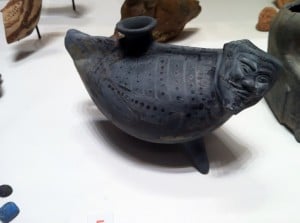
Dr. Siolas took a photo of a vase shaped like a bird with the head of Silenus. The brochure states “it may be linked to the river god Achelous.” AKHELOIOS (or Achelous) was a River-God of Aitolia in central Greece. He was the god of the largest fresh-water river in Greece (http://www.theoi.com/Potamos/PotamosAkheloios.html-).
Sixth century Marseille coins inspired Gallic communities to produce their own coins in the first century B.C. “During his conquest of Gaul, Caesar reported that the Helvetii were in possession of documents in the Greek script, and all Gaulish coins used the Greek script until about 50 BCE. Coins in northern Gaul were especially influenced by the coinage of Philip II of Macedon and his famous son Alexander the Great.
Celtic coins often retained Greek subjects, such as the head of Apollo on the obverse and two-horse chariot on the reverse of the gold stater of Philip II, but developed their own style from that basis, thus establishing a Graeco-Celtic synthesis. By the 1st century BCE, the coinage of the Greeks of Marseille circulated freely in Gaul, also influencing coinage as far afield as Great Britain. The coins of the Sunbury hoard, thought to have been manufactured in Kent, show designs derived from Greek coins from Marseille with the stylized head of Apollo and a butting bull (http://en.wikipedia.org/wiki/Marseille).
Artemis, the Greek Goddess, interested Dr. Siolas. She visited Ephesus of Asia Minor. Turkey, seeing similar statues. “The Phocaean Greeks introduced the cult of Artemis, as in their other colonies,” according to http://en.wikipedia.org/wiki/Marseille. “At Ephesus in Ionia, Turkey, her temple became one of the Seven Wonders of the World…. There the Lady whom the Ionians associated with Artemis.. worshiped primarily as a mother goddess…depicted the ‘Lady of Ephesus’.” (http://en.wikipedia.org/wiki/Temple_of_Artemis). The Gauls adopted Greek building fortifications and brickwork techniques, such as the site of La Cloche and the Greek alphabet for transcribing their own language in writing.
War between the 2nd generation Greeks and Gauls flared up (Set 1.2 of Marseillle and the Gauls of Provence, tour diary of Musee D’ Histoire De Marseille). The arrival of new Phocaeans began around 540 B.C. after the Persian invasion of the Mother City in Asia Minor. The Massalians took over more land to cultivate their vines at the expense of Gallic farms. Marseille appealed to Rome for help during its history to extricate itself from the grip of the Gauls. The Romans destroyed Gallic settlements from 125-123 B.C. The siege and capture of Marseille by Caesar in 49 B.C. ended its independence.
In Series 2 in “The World of Pytheas:380-49 B.C,” the following quote by Winston Churchill, British Prime Minister, 1874-1965, introduces the topic: “That fine sailor, Pytheas of Marseille, must surely have been one of the greatest explorers history has ever known. He confirmed and proclaimed the existence of the British Isles. He was treated like a liar, and it was only long after the disappearance of the world in which this great sailor had lived, that people began to have some admiration for the discoveries he had made,” (p. 10, “Musee D’Histoire De Marseille).
Pytheas of Massalia was a Greek geographer and explorer from the Greek colony, Massalia (modern day Marseilles). He made a voyage of exploration to northwestern Europe at about 325 BC. In this voyage, he travelled around and visited a considerable part of Great Britain. He is the first person on record to describe the Midnight Sun. The theoretical existence of a Frigid Zone where the nights are very short in summer and the sun does not set at the summer solstice was already known. Similarly, reports of a country of perpetual snows and darkness, the country of the Hyperboreans, had been reaching the Mediterranean for some centuries. Pytheas is the first known scientific visitor and reporter of the Arctic, polar ice, and the Germanic tribes. He is the one who introduced the idea of distant Thule (Norway) to the geographic imagination. His account of the tides is the earliest to state that they are caused by the moon (http://en.wikipedia.org/wiki/Pytheas).
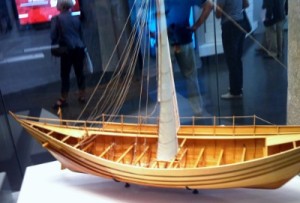
The Marseilles 2013 Exhibit is revealing to the global community the navigation knowledge of the Ancient Greeks destroyed by the fanaticism during the Dark Ages. “The ancient Greek navigation view of the heavenly bodies, imported from Babylonia (Iraq) by the Ionian Greeks,” according to http://en.wikipedia.org/wiki/Pytheas_of_Massilia. “The Ionian Greeks used it to become a seafaring nation of merchants and colonists during the ancient period of Greece. Massalia was an Ionian colony. The first Ionian Philosopher, Thales, was known for his ability to measure the distance of a ship at sea by the very method Pytheas used to determine the latitude of Massalia, the trigonometric ratios. The astronomic model on which Ancient Greek navigation was based is still in place today…”
The islanders of Chios and Samos are inheritors of the Ionian civilization (http://www.greeknewsonline.com/?p=7259). In particular, the Chian merchant marine controls more than 40% of Greek shipping. Greek owned shipping stands today in first position worldwide (http://www.qgazette.com/news/2013-08-14/Front_Page/Viewpoint_Chios_Merchant_Shipping_a_Success_Story.html and
Massalia had a naval fleet which is frequently mentioned in written sources: battles against the Carthaginians; the naval battle of Saguntum during the Second Punic War in 219 B.C. and the battle against Caesar’s fleet during the siege of 49 B.C., according to “The World of Pytheas, 380-49 B.C.” in Series 2, tour diary. The “Constitution of Marseille and its Policy of Expansion” is explained in Exhibit 2.4. “In the first century B.C., the Greek geographer and philosopher Strabo referred to the administration of Marseille as being halfway between a democracy (with the power in the hands of the people) and an oligarchy (with the power in the hands of a small group of people). …Women, foreigners and slaves were excluded from political life, just as they were in other Greek cities.”
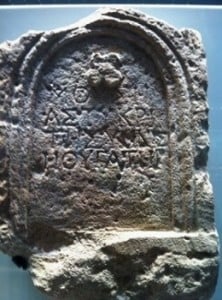
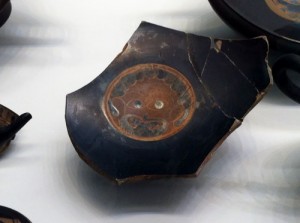
The history of the excavation at the Bourse, eastern side of the ancient city is explained in detail from 600 BC to the present day in tour diary Series 3.It is the first major urban archaeological dig in France showing Roman warehouses, two Hellenistic burial terraces and ancient wells and ancient port.
Series 4 “From Massalia to Massilia: The Roman City” shows the endurance of the Greek Language and culture under Roman rule. “Massalia was conquered by Julius Caesar and his legate Trebonius in 49 BC.,” according to the tour guide. “The city thus lost its independence, but it remained an active port and retained its Greek character for a considerable length of time. The settlement developed in the old port area….Despite the gradual process of Romanization which manifested itself in the increased use of Latin, in the architecture and décor of the houses and in funeral practices, the Greek cultural legacy lived on in the urban fabric, in its policies and its districts. It was evident in the frequent use of the Greek language on inscriptions.”
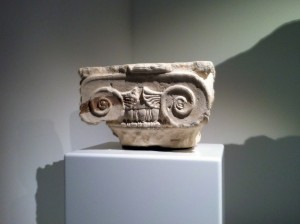
Exhibit 4.3 highlights this fact: the city remained Greek in its habits and customs. “The permanence of the Greek language also reveals the stability of a population whose Greek names slowly became romanized, but were often written in Greek!” states the tour guide. When I visited Syracuse with Dr. Gaetano Cipolla’s Arba Sicula tour, the same fact was emphasized: pride in one’s Greek heritage “The Greeks were colonizers. They created all their economic power through work and sacrifice,” said Salvatore Furnari in his book, Myths, Legends and Customs in Greek and Roman Sicily. “We must say that the Greeks, among ancient peoples, were those that used slaves the least. They respected and never brutalized them. Even though they were excellent warriors, the Greeks were peaceful people who preferred colonizing to occupying. For them, war was their last remedy.” (http://www.qgazette.com/news/2008-07-09/features/024.html and http://www.greeknewsonline.com/?p=8854).
Sources:
Photography by Despina Siolas, MD/PhD.
“Groupement Pour La Reconstitution Du Porte De Marseille Obligation 5%,” “Musee D’Histoire De Marseille” tour diary.
http://en.wikipedia.org/wiki/Greeks_in_pre-Roman_Gaul
http://en.wikipedia.org/wiki/Marseille
http://en.wikipedia.org/wiki/Phocaea
http://en.wikipedia.org/wiki/Ionians
http://en.wikipedia.org/wiki/Artemis
http://en.wikipedia.org/wiki/Temple_of_Artemis
http://en.wikipedia.org/wiki/Pytheas_of_Massilia
http://www.mercurynews.com/ci_23448168/travel-museum-hopes-transform-frances-crime-hit-marseille
http://www.theoi.com/Potamos/PotamosAkheloios.html- River God Achelous.
http://en.wikipedia.org/wiki/Pytheas
See all the latest news from Greece and the world at Greekreporter.com. Contact our newsroom to report an update or send your story, photos and videos. Follow GR on Google News and subscribe here to our daily email!



